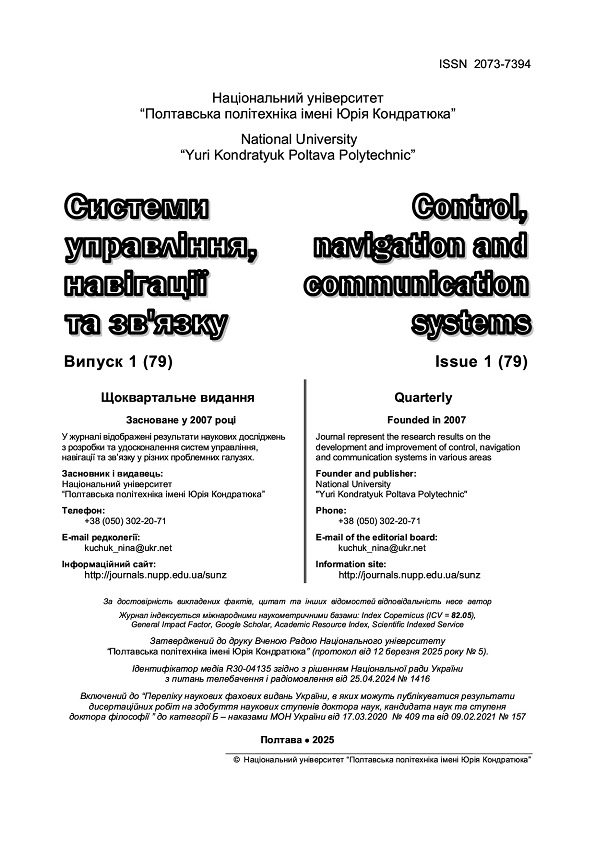Modelling of vertical oscillations of a train arising during movement on a railway track with a joint unevenness
DOI:
https://doi.org/10.26906/SUNZ.2025.1.49-54Keywords:
mathematical model, decision support system, on-board control systems, rolling stock, oscillatory process, bouncing, galloping, resonant speedAbstract
Rail transport has been one of the main carriers f goods and passengers in Ukraine for many years. Despite this,
most trains and rails on the main routes are in poor condition. In the context of the ongoing war and the subsequent long post-war
recovery, the issues of extending the life of existing rolling stock and saving energy resources are at the forefront. In addition, to
maintain the competitiveness of trains relative to other modes of transport, the issue of increasing average speeds and passenger
comfort on the railway is crucial. To solve these problems, it is necessary to develop comprehensive models that take into account
factors that significantly affect fuel consumption, safety and passenger comfort. Such factors include rolling stock oscillations This
paper is devoted to the development of a simulation model of vertical oscillations (bouncing and galloping) of the body and bogies of
a train carriage, which depend on unevenness of the railway track. The developed complex simulation model of train car movement
on a track, taking into account vertical oscillations of the car body and its bogies in the MATLAB/Simulink package, allows to study
the dependence of these oscillations on the speed of the rolling stock, parameters of its suspension system and unevenness of the track
under the wheel pairs not only in the mode of maintaining a given speed, but also in the run-up mode and transient modes (acceleration,
deceleration). The obtained simulation model can be used to further study the oscillatory processes of a train on selected sections of
the track, as well as to obtain data for training a neural network for early detection of resonant vibrations of a train car, and can also
be used in decision support systems (DSS) of on-board control systems for rolling stock of Ukrainian trains.
Downloads
References
1. Інформаційне агенство УНІАН. Мінінфраструктури про стан потягів "УЗ": на 90% – металобрухт URL:https://www.unian.ua/economics/transport/metalobruht-u-mininfrastrukturi-vislovilisya-pro-stan-potyagiv-uz-noviniukrajina-11603764.html
2. Каюкін В. О. Управління конкурентноспроможністю пасажирських перевезень залізничним транспортом в Україні: Проблеми та аналіз. Молодий вчений, 10 (62), 707-711. https://molodyivchenyi.ua/index.php/journal/article/view/3871
3. Lin, J.; Wang, K.; Zhai, W. Impact vibration behavior of railway vehicles: A state-of-the-art overview. Acta Mech. Sin. 2021, 37, 1193–1221. DOI: https://doi.org/10.1007/s10409-021-01140-9
4. Сокол Э. Н. Крушение железнодорожных поездов (Судебная экспертиза). Монография. – К.: Феникс, 2007. – 355 с.
5. Заковоротный А. Ю. Синтез автоматизированной системы управления подвижным составом на основе геометрической теории управления и нейронных сетей: дис. ... д-ра техн. наук : спец. 05.13.07 Нац. техн. ун-т "Харьков. политехн. ин-т". – Харьков, 2017. – 433 с. URL: https://repository.kpi.kharkov.ua/handle/KhPI-Press/28330
6. Костриця С. А. Математична модель вагона дизель-поїзда ДПКр-2 / С. А. Костриця, Ю. Г. Соболевська, А. Я. Кузишин, А. В. Батіг // Вісн. Дніпропетр. нац. ун-ту залізн. трансп. ім. акад. В. Лазаряна. 2018. – № 1 (73). – C. 15–25.
7. Кузишин А. Я. Удосконалення методів визначення основних динамічних показників моторвагонного рухомого складу на стадії проектування: дис. Доктор філософії : спец. 273 Залізничний транспорт : Дніпровський нац. ун-т. залізничного транспорту ім. ак. В.А. Лазаряна – Дніпро, 2019. – 144 с.
8. Garg, Vijay Kumar, and Rao V Dukkipati. Dynamics of Railway Vehicle Systems. New York: Academic Press, 1984. DOI: https://doi.org/10.1016/B978-0-12-275950-5.50016-X
9. João Pombo, Jorge A.C. Ambrósio, Miguel T. Silva. A new wheel-rail contact model for railway dynamic.Vehicle systems dynamics. – 2007. – P. 31-49. DOI: https://doi.org/10.1080/00423110600996017
10. Wang, X., Lu, Z., Wen, J. et al. Kinematics modelling and numerical investigation on the hunting oscillation of wheel–rail nonlinear geometric contact system. Nonlinear Dyn 107, 2075–2097 (2022). https://doi.org/10.1007/s11071-021-07103-w DOI: https://doi.org/10.1007/s11071-021-07103-w
11. Sun J., Jiao W., Ur Rehman A. Hunting frequency variation mechanism and its effect on carbody hunting stability for railway vehicles. Acta Mech. Sin., Vol.39, 523046 (2023). https://doi.org/10.1007/s10409-023-23046-x DOI: https://doi.org/10.1007/s10409-023-23046-x
12. Silva P., Mendes J., Seabra E, Pratas P. Railways Passenger Comfort/Discomfort: Objective Evaluation. New Research on Railway Engineering and Transportation, 2023. DOI: 10.5772/intechopen.111704 DOI: https://doi.org/10.5772/intechopen.111704
13. U.S. Department of Transportation. Federal Railroad Administration. Measuring the Displacement Environment between a Locomotive and Trailing Car. Final Report Report May 2020.
14. Лукашова Н. П. Підвищення ефективності роботи ходової частини рейкового міського транспорту з використанням електромеханічних амортизаторів: дис. … канд. техн. наук: спец. 05.22.09 Електротранспорт: Харківський нац. ун-т міського господарства ім. О. М. Бекетова – Харків 2020 – 162 с.
15. Abood K. H. A., Khan R. A. Railway carriage simulation model to study the influence of vertical secondary suspension stiffness on ride comfort of railway carbody. Proc. IMechE Vol. 225 Part C: J. Mechanical Engineering Science, 2011 https://doi.org/10.1177/0954406211399809 DOI: https://doi.org/10.1177/0954406211399809
16. Yokesh K. S., Nandakumar N. Modelling and Sensitivity Analysis of Influencing Parameters in Displacement of Dynamic Bodies. Engineering and Technology Journal, 2021, p. 879-883 DOI: 10.47191/etj/v6i5.02, I.F. – 6.39 DOI: https://doi.org/10.47191/etj/v6i5.02
17. Klimenda F., Skocilas J., Skocilasova B., Soukup J., Cizek R. Vertical Oscillation of Railway Vehicle Chassis with Asymmetry Effect Consideration. Sensors 2022, 22, 4033. https://doi.org/10.3390/s22114033 DOI: https://doi.org/10.3390/s22114033
18. Yu Y., Zhao L., Zhou C. A new vertical dynamic model for railway vehicle with passenger-train-track coupling vibration. Proc IMechE Part K: J Multi-body Dynamics 2020, Vol. 234(1) p. 134–146. DOI: 10.1177/1464419319879790 DOI: https://doi.org/10.1177/1464419319879790
19. Кудрявцев Н. Н., Белоусов В. П., Бурчак Г. П. Определение вертикальных возмущений, вызывающих колебания обрессоренных частей вагона при движении по рельсовому пути // Вестник ВНИИЖТ. 1982. № 5. С. 33–37
20. Решетнікова П. Е. Математична модель вертикальних коливань рухомого складу, викликаних нерівностями залізничної колії / Решетнікова П. Е., Заковоротний О. Ю. // Системи управління, навігації та зв’язку. Том 4 № 78, 2024, с. 42–45 https://doi.org/10.26906/SUNZ.2024.4.042 DOI: https://doi.org/10.26906/SUNZ.2024.4.042
Downloads
Published
Issue
Section
License

This work is licensed under a Creative Commons Attribution-NonCommercial 4.0 International License.




